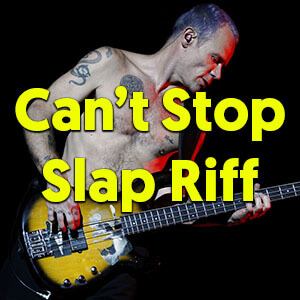Many famous and popular slap riffs are actually fairly tricky for beginners. Today’s riff is written specifically for this lesson and allows you to practice the basic techniques of both slapping and popping, your note control in the fretting hand, a clean technique by way of muting and your hammer on’s. It’s an incredibly simple riff from a musical standpoint, but it’s packed with content for subtle focused practice.
The Perfect Beginner Slap Bass Riff!!
The Riff
So what we have here is a basic rhythm with some variation towards the end of each bar. As you can see on the stave below, bars one and three are repeated. It’s in bars two and four where we see the variation. This riff has a very steady rhythm to it with staccato on the down beats of beats one and three, we have rests on beat two and again on the down beat of beat four.

Notes and Rhythms
On beats one and three throughout this riff, we play a simple open E. A lot of well known slap parts are played in this particular key, the Key of E minor, as it’s that little bit easier to slap the open E string on a four string bass. The down beat each time is cut short, which you can see by the use of the staccato symbol below the note on the stave and directly above it on the TAB.
In bar one on the off beat of beat four, we see a slapped hammer on from D to E, this is repeated again in bar three. In bars two and four however, we see our first popped hammer on’s. In bar two, this is a popped F# to G on the D string and in bar three, this is a popped D to E on the G string. These are played as 16th notes, so be sure to count along as you play and get the correct feel for these beats.
Slap/Pop Technique
There are a few techniques here to consider; slap and pop. For the slap technique you should ideally keep the thumb paralell to the string you want to slap, in this case the open E. Then in a twisting motion, you quickly bounce your thumb off the string. Your wrist movement should almost be like twisting open a door knob, you should not slap with your whole arm! Aim the boney part of the side of your thumb at the string just towards the end of the fretboard, this will give you that quintessential slap sound.
For the popping technique, you just hook either your index or middle finger under the string you want to pop and quickly pull it away from the fretboard to give it that zingy almost snare-like sound. The fresher your strings, the brighter this will sound!
The Fretting Hand
Everyone thinks that the fretting hand is not as important when it comes to slapping, but it plays a very important role. I use a technique I’ve called the “Home” position, which is a great default position to use to gain maximum control and comfort when fretting. Using your thumb as an anchor, you place it at the back of your neck and use it to pivot your fingers around the fretboard. Then you splay your fingers across the board, this keeps all the string muted when not playing. This is also great when you advance to incorporating ghost notes and muting into your playing in true Les Claypool style!
Note Control Exercises
Now that your fretting hand is in order, you can get stuck in to some note control exercises. This might seem pedantic, but I’ve noticed a lot of beginners have issues in this area. If left unchecked, this bad habit can really mess up your technique and sound. This why I’ve incorporated the staccato and full 1/4 note on beat one of each bar in this riff. Really focus your attention on getting this down and it will make a big difference to your playing.
Hammer On’s
This is when you play one note, then use a finger in your fretting hand to hit down on to the next note. A literal hammer on to the next note rather than just playing it normally. This gives a funky, loose sound with an almost wah-wah like quality. Try to get both notes to the same volume, as the note which is hammered on does have a tendency to ring out a little quieter.
Applying Technique To The Riff
Finally we put all that we have learned together to get play this riff. Remember to start as slowly as you need to, and really focus on all the intricacies of the piece. Really try to master getting the note duration correct, the accuracy of your slap stroke down, the tone of your popping and the precision and consistency of your hammer on’s. It’s all of these little subtleties that will make the big difference in your slap playing. If you enjoyed this video lesson and want to learn more, there are a tonne of video lessons over at my YouTube channel and on the TalkingBass website. Be sure to check out my Simple Steps To Slap Bass course too!













Leave A Comment